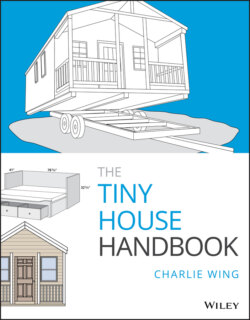Читать книгу The Tiny House Handbook - Charlie Wing - Страница 14
On Wheels
ОглавлениеMost people, when hearing the term tiny house, picture a conventional but narrow house built on a trailer. The appeal is not only in its less-is-more statement, but the suggestion of total independence.
While the freedom to go anywhere is true, the freedom to stay is more complex. Most zoning considers tiny homes on wheels akin to recreational vehicles and campers which are not subject to real estate taxes. They are thus considered squatters and are generally limited to stays of several months maximum.
And like RVs, tiny homes on wheels have to provide for—at least temporarily—their own electricity, water, and sewage. Like perpetual motion, total shelter freedom is still an elusive dream.
Like mobile homes and RVs, they were on wheels, but they were constructed of wood and actually looked like houses.
Being on wheels they also fed our desire for freedom. “Hasta la vista, I’m out of here!”
Having your home, like a turtle, “on your back” meant changing jobs would no longer require selling the old and buying new.
In 2007 Jay and his tiny home appeared on the Oprah Winfrey Show.
Finally, in 2017, the International Residential Code officially recognized tiny homes as “houses that are 400 square feet in area or less.” In consultation with Jay and others the IRC added Appendix Q, allowing space-saving exceptions for stairs and sleeping lofts and egress (in case of fire) from roof windows.
